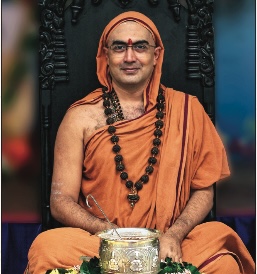MINISTER’S MESSAGE
STEPS TO REACH THE ABSOLUTE
______________________
To attain our true Self requires honing our humility and aspiration through service, fitness and purification, followed by consistent meditation
______________________
B Y H I S H O L I N E S S S A D Y O J A T S H A N K A R A S H R A M S W A M I J I
Aside from his social service work, Swamiji is a raja yoga adept. He regularly conducts guided meditation sessions in two complementary forms. One is indoors, with eyes closed in the traditional manner. The other, known as Ashtamoorti Upasana, is outdoors, with eyes open, at a scenic spot where the participant is taught how to meditate on the elements and arrive at one’s True Self in an illuminating, methodical and unhurried manner. Swamiji shares these thoughts about sadhana.
SEVA PLAYS AN IMPORTANT ROLE IN THE aspirant’s search for the Absolute, the Ultimate Truth. It brings about purification, strengthens the connection with the Divine and thus helps to stabilize a sadhaka’s spiritual search. The earnest desire to learn, shrotum iccha, is slowly built up through seva. Along with this is kindled the awareness of both the benefits and the responsibilities of a serious seeker. You begin to stop paying attention to that “me, me” feeling as you try keenly to understand more about the principle of serving others. Thus the mind is occupied and alert, but its dependence on the ego begins to lessen. It is no longer “I-centric.”
When you work within a group, you gradually learn to assert or tone down your opinion as needed, because here the goal is more important than petty concerns like “I have been insulted” or “I did the work and someone else took the credit.” There is an element of dispassion, tyaga, in your effort, because it is not made for personal gain. When you are serving your master, your guru, there is a lot of reverence and purity in your actions, because you look up to him and are giving without any selfish motive. Seva done in the right spirit is the first step towards true surrender.
Physical fitness is also very important. Making time for exercise is a must. The good effects of a regular workout can be felt very soon. If you do not have a proper diet and are overweight and unhealthy, you cannot have the tenacity that is required for sustained spiritual practice. Moderation is the key for fitness of the body and consequently of the mind as well.
Then we can take steps in meditation. The untrained mind is like a child who needs to be placated before getting disciplined and drawn towards the right point of focus. The mind harbors many samskaras—inherited traits and conditioning—which cannot be erased in a trice. That is why mantra-japa is advised. Concentration on a mantra helps a beginner, in particular, to hold other thoughts at bay until he realizes that he is learning to surrender to a divine force that exists within and without. Consistency helps the seeker to shed all the negativity within until he understands that “pure” is not what he has to become. “Pure” is who he is!
The mind has to be made aware of the need for relaxation, the need for discovering something very calm, very peaceful. Feeling that I am wasting my time because I am not “doing” anything is self-defeating. Doing a few warm-ups and exercises, breathing deeply and learning yogic processes—like kapalbhati or anulom-vilom (breathing exercises) from a qualified teacher—enable your body and mind to receive the fruits of meditation.
Regular meditation can bring mental equipoise, strengthen your willpower immensely, generate enthusiasm and inspiration in day-to-day tasks and thereby enhance your efficiency. Meditation, therefore, is a must to learn how to draw upon your inner resources, how to connect with your Higher Self.
In the initial stage of sadhana, having accepted that this is as a place for learning, the seeker is filled with zeal; he is respectful and eager to follow, even imitate all that he observes in the guru. This infuses a certain discipline; it gives his mind lessons about some dos and don’ts. He does not seek any explanation, nor is he ready to receive it at this point of time.
Gradually, unconsciously, he begins to develop a shivmayi drishti (purity of thought and outlook). His negative thinking fades away because amangalata (any form of impure thought or behavior) has absolutely no chance to flourish. His ability to see and appreciate the good in others increases, along with tolerance and acceptance. His spontaneity, clarity of mind and the need to express this creative energy in better and better ways accelerates.
Finally he becomes ready and worthy to receive the grace that was waiting to bless him. There is a complete burning away of all the limitations that were earlier the identification marks for his ego. The petty ego now gives way to total purity, the shuddha aham, and the blissful discovery that “I am not who I thought I was! This shivatwa—this totality and vastness of pure consciousness—of which I was getting glimpses now and then—is my own swarupa, my True Self!”
HIS HOLINESS SADYOJAT SHANKARASHRAM SWAMIJI, 48, is 11th in the Paramapara of Mathadhipathis of Shri Chitrapur Math, Shirali, Karnataka, India, the spiritual sanctum of 25,000 Chitrapur Saraswats scattered all over the globe. See www.chitrapurmath.net [http://www.chitrapurmath.net]
